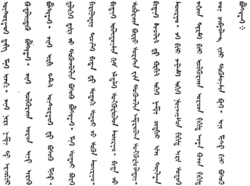
Back Тодо бэшэг BXR Todo bičig Czech Klarschrift German Mongoli selge kiri Estonian Todo bitšig Finnish Todo bitchig French Tod bicsig írás Hungarian トド文字 Japanese ტოდო-ბიჩიგი Georgian Тодо бичиг Kazakh
| Clear Script Oirat alphabet | |
|---|---|
 | |
| Script type | |
| Creator | Zaya Pandita |
Time period | ca. 1648 – today |
| Direction | Vertical left-to-right |
| Languages | Oirat Sanskrit Tibetic |
| Related scripts | |
Parent systems | |
Sister systems | Manchu alphabet Vagindra script |
| ISO 15924 | |
| ISO 15924 | Mong (145), Mongolian |
| Unicode | |
Unicode alias | Mongolian |
| U+1800 – U+18AF | |
The Clear Script (Oirat: ᡐᡆᡑᡆ
ᡋᡅᡒᡅᡎ / Тодо бичиг, romanized: todo bičiq / todo bičig, [todo bit͡ʃ(ə)k]; Mongolian: Тод бичиг / ᠲᠣᠳᠣ
ᠪᠢᠴᠢᠭ, romanized: tod bichig / todo bičig, [tɔd bit͡ʃək], Russian Buryat: Тодо бэшэг, romanized: Todo besheg, ([tɔdɔ bɛʃək]), or just todo) is an alphabet created in 1648 by the Oirat Buddhist monk Zaya Pandita for the Oirat language.[1][2][3] It was developed on the basis of the Mongolian script with the goal of distinguishing all sounds in the spoken language, and to make it easier to transcribe Sanskrit and the Tibetic languages.

- ^ N. Yakhantova, The Mongolian and Oirat Translations of the Sutra of Golden Light Archived 2016-04-07 at the Wayback Machine, 2006
- ^ Kara, György (2005). Books of the Mongolian Nomads: More Than Eight Centuries of Writing Mongolian. Indiana University, Research Institute for Inner Asian Studies. ISBN 978-0-933070-52-3.
- ^ Daniels, Peter T.; Bright, William (1996). The World's Writing Systems. Oxford University Press. ISBN 978-0-19-507993-7.